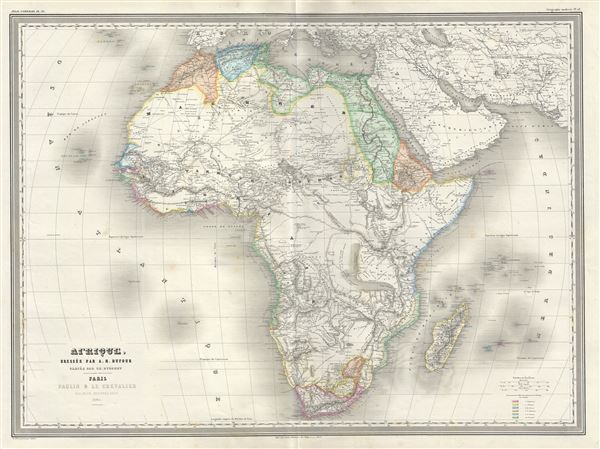This item has been sold, but you can get on the Waitlist to be notified if another example becomes available, or purchase a digital scan.
1860 Dufour Map of Africa
Afrique-dufour-1860
Title
1860 (dated) 23 x 31 in (58.42 x 78.74 cm) 1 : 31700000
Description
Mt. Kenya, first sighted by western explorers in 1849 is identified. Africa is largely 'unexplored' though Lake Uniamesi, something that may be taken for an embryonic form of Lake Victoria, Lake Tanganyika, Lake Nyasa or all three of the Great Rift Valley lakes combined, does appear. This curious lake, supposedly identified by three missionaries in the 1840s and 1850s, was frequently written of in mid-century missionary reports as the source of several important African river systems, including the Congo. It was not until the expeditions of John Hanning Speke and Richard Burton in the late 1850s and early 1860s, that it was discovered that lakes Victoria, Tanganyika and Nyasa were in fact separate. The speculative source of the Nile is shown to be somewhere south of the equator.
At the time this map was made, the slave trade, thriving since the 5th century was rapidly diminishing due to decreased demand for slaves in the New World, the British outlawing of slavery in 1808, and subsequent diplomatic efforts including treaties with over 50 African rulers outlawing the practice. Many African economies adapted by shifting to the export of mineral and agricultural resources, which led to the European scramble for territory, occupying most of the continent by the end of the 19th century. Europe's colonial interests in Africa haphazardly carved up the continent into unnatural territories, often forcing historic enemies into close proximity and leading to social problems that remain to this day.
This map was prepared by Auguste-Henri Dufour and engraved by Charles Dyonette for publication plate no. 35 in Armand Le Chevalier's 1860 edition of Atlas Universel, Physique, Historique et Politique de Geographie Ancienne et Moderne.
CartographerS
Adolphe Hippolyte Dufour (1795 - 1865), also known as Auguste-Henri Dufour, was a Paris based map and atlas publisher active in the middle to late 19th century. Dufour claimed to be a student of another French cartographer, Emile Lapie. He is known to have worked with numerous other French cartographers, publishers, and engravers of the period including Andriveau-Goujon, Charles Dyonnet, and Duvotenay. His corpus includes numerous maps and atlases, the most striking of which is probably his monumental elephant folio Atlas Universel Physique, Historique et Politique Geographie Ancienne et Moderne. Dufour's student and successor was Alexandre Vuillemin. More by this mapmaker...
Charles Dyonnet (fl. c. 1822 - c. 1880) was an extremely active Paris based engraver working in the mid to late 19th century. From his offices at 220 Rue St. Jacques, Paris, Dyonnet engraved numerous maps for many of the most prominent 19th French cartographic publishers including Vuillemin, Dufour, Fremin and Duvotenay. From 1850-1861, he held the coveted position of "Graveur du Dépot de la Marine," and in this position engraved numerous French naval and military maps. Dyonnet had a detail oriented and aesthetically minded hand and is responsible from some of the most beautiful French maps to emerge during the 19th century. Learn More...

